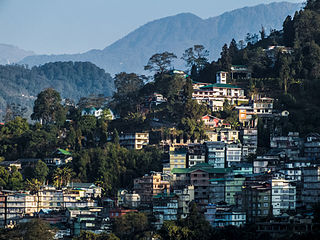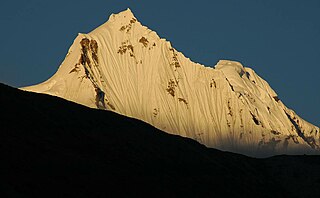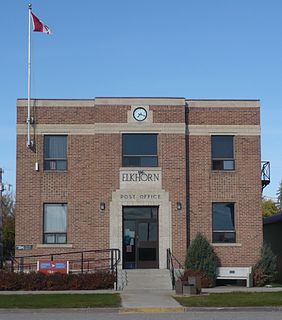
Sikkim is a state in northeastern India. It borders the Tibet Autonomous Region of China in the north and northeast, Bhutan in the east, Province No. 1 of Nepal in the west, and West Bengal in the south. Sikkim is also close to the Siliguri Corridor, which borders Bangladesh. Sikkim is the least populous and second smallest among the Indian states. Situated in the Eastern Himalaya, Sikkim is notable for its biodiversity, including alpine and subtropical climates, as well as being a host to Kangchenjunga, the highest peak in India and third highest on Earth. Sikkim's capital and largest city is Gangtok. Almost 35% of the state is covered by the Khangchendzonga National Park – a UNESCO World Heritage Site.

The Hindu is an English-language, Indian daily newspaper owned by The Hindu Group, headquartered in Chennai, Tamil Nadu. It began as a weekly in 1878 and became a daily in 1889. It is one of the Indian newspapers of record and the second most circulated English-language newspaper in India, after The Times of India. As of March 2018, The Hindu is published from 21 locations across 11 states of India.

Agsu District is one of the 66 districts of Azerbaijan. It is located in the east of the country and belongs to the Mountainous Shirvan Economic Region. The district borders the districts of Ismayilli, Shamakhi, Kurdamir, and Hajigabul. Its capital and largest city is Agsu. As of 2020, the district had a population of 81,000.

Gangtok is a city, municipality, the capital and the largest populated place of the Indian state of Sikkim. It is also the headquarters of the Gangtok District. Gangtok is in the eastern Himalayan range, at an elevation of 1,650 m (5,410 ft). The city's population of 100,000 are from different ethnicities of Sikkimese people such as Nepali, Bhutia and Lepchas. Within the higher peaks of the Himalayas and with a year-round mild temperate climate, Gangtok is at the centre of Sikkim's tourism industry.

North Sikkim is a district of the Indian state of Sikkim. Its district headquarters is Mangan. It is the seventh least populous district in the country.

Wallaceburg is an unincorporated community in the municipality of Chatham-Kent in Southern (Southwestern) Ontario, Canada. Originally a small settlement, it was recognized for its significant contribution to the lumber and boat building industries and strategic location along the banks of the scenic Sydenham River. In more recent years, 1895–1999, the town was known for its glass making industry. For that reason, Wallaceburg is locally known as the "glass town of Canada."
Hoshiarpur District is a district of Punjab state in northern India. Hoshiarpur, one of the oldest districts of Punjab, is located in the North-east part of the Punjab state and shares common boundaries with Gurdaspur district in the north-west, Jalandhar district and Kapurthala district in south-west, Kangra district and Una district of Himachal Pradesh in the north-east. Hoshiarpur district comprises 4 sub-divisions, 10 community development blocks, 9 urban local bodies and 1417 villages. The district has an area of 3365 km2. and a population of 1,586,625 persons as per census 2011.

Gauri Khan is an Indian film producer and fashion designer who works in Hindi films and designer. She has produced films including Main Hoon Na, Om Shanti Om and Chennai Express under the production company Red Chillies Entertainment that she co-founded in 2002 with her husband, actor Shah Rukh Khan.
Lady Shri Ram College for Women (LSR) is a constituent women's college, affiliated with the University of Delhi, and has a legacy in women's education.

The Jaldhaka River (Pron:/ˌdʒælˈdɑːkə/), also known as Dichu, a tributary of Brahmaputra is a trans-boundary river flowing through India, Bhutan and Bangladesh with a length of 233 kilometres. It originates from the Bitang Lake of Pangolakha Wildlife Sanctuary in Pakyong District, Sikkim, just below the Jelep La pass. It flows through Pakyong District and then passes through Bhutan's Samtse District and reenters India at Bindu, Kalimpong district. After flowing through the Kalimpong, Jalpaiguri and Cooch Behar districts of West Bengal, India, the river enters Bangladesh through the Lalmonirhat District of Rangpur Division. It is known as Dharla River in Bangladesh until the Dharla debouches into the Brahmaputra River near the Kurigram District. Due to the river's wandering over several international borders, only a small length of the river lies in Bangladesh and Bhutan and most of its path lies in India. In some places, this river is also known as Mansai river and Singhimari river.

Elkhorn is an unincorporated community recognized as a local urban district in the Rural Municipality of Wallace – Woodworth within the Canadian province of Manitoba that held village status prior to January 1, 2015. It was originally incorporated as a village on January 2, 1906. Elkhorn is located approximately 105 kilometres (65 mi) west of Brandon.

Gurudongmar Lake is one of the highest lakes in the world and in India, at an elevation of 5,430 m (17,800 ft) according to the Government of Sikkim. It is located in the Great Himalayas in the Mangan District in Indian state of Sikkim, and considered sacred by Buddhists, Sikhs and Hindus. The lake is named after Guru Padmasambhava—also known as Guru Rinpoche—founder of Tibetan Buddhism, who visited in the 8th century.

Lankesh Patrike is an Indian vernacular weekly published in Kannada language from Bangalore, Karnataka.
Aritar is a region in the Pakyong District of the Indian state of Sikkim under Rongli Sub-Division. It is known for its natural and landscaped beauty. It is located on the edge of the Himalayas, and can be reached in about four hours' drive from Gangtok via either Pakyong or Rangpo.

The following outline is provided as an overview of and topical guide to Nepal:
Bedani, also known as Bedani Kalan, is a small village located in Tarhasi Block of Palamu District in the state of Jharkhand, India). It lies on the banks of the Amanat River some 30 km from the District town of Medininagar (Daltonganj)
Sangbay or Sangbaykha Gewog is a gewog of Haa District, Bhutan. It is one of the western gewogs of the Haa district sharing borders with the Samtse District, India's Sikkim state and China's Chumbi Valley. The latter border has been contested by China, which claims the Doklam region as its territory. In recent years, China has begun to build villages in its claimed area.

Indian Gorkhas, also known as Nepali Indians, are Nepali language-speaking Indians. The modern term "Indian Gorkha" is used to differentiate the ethnic Indian Gorkha from Nepalis.
Mahendra P. Lama is an Indian professor and a development economist who was the pro-vice chancellor of IGNOU and the founding vice chancellor of Sikkim University in India. At the age of 45, he became the youngest vice chancellor of a National Central University in India. He is presently a senior Professor in the School of International Studies, Jawaharlal Nehru University, New Delhi; Chief Economic Adviser in the Government of Sikkim and Member of the Eminent Persons Group on Nepal-India Relations appointed by the Prime Ministers of India and Nepal.

The Chauri Chaura incident took place on 4 February 1922 according to the Indian government's official data at Chauri Chaura, in the Gorakhpur district, in the United Provinces, in British India. The police there fired upon a large group of protesters participating in the Non-Co-Operation Movement. In retaliation, the demonstrators attacked and set fire to a police station, which killed all of its occupants. The incident led to the death of three civilians and 22 policemen. Mahatma Gandhi halted the Non-Cooperation Movement on the national level on 12 February 1922 as a direct result of the incident. In spite of Gandhi's decision, 19 arrested demonstrators were sentenced to death and 14 to life imprisonment by the British colonial authorities.














